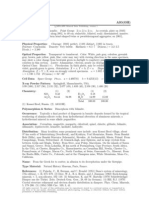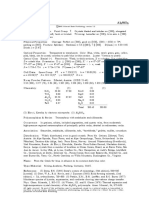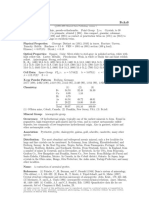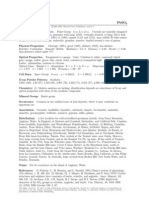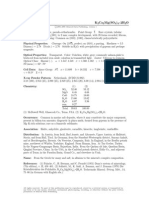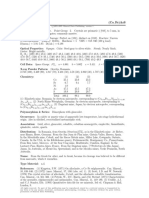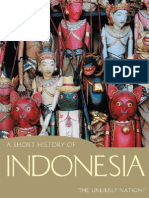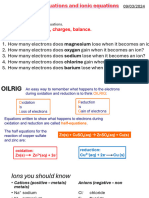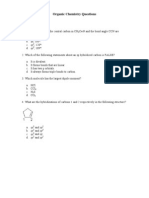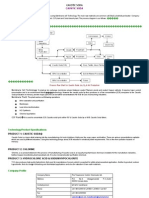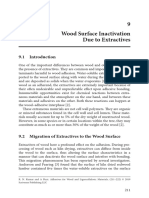0 ratings0% found this document useful (0 votes)
78 viewsGoethite
Goethite
Uploaded by
Dedi ApriadiGoethite is an iron oxide mineral with an orthorhombic crystal structure. It commonly forms prismatic crystals that are striated along the c-axis or tabular crystals forming on the {010} plane. It also forms fibrous, botryoidal, or stalactitic masses. Goethite is a common weathering product that forms in oxygenated environments from the oxidation of iron-bearing minerals. It is also a primary mineral that precipitates from hydrothermal fluids, marine environments, and bogs.
Copyright:
Attribution Non-Commercial (BY-NC)
Available Formats
Download as PDF, TXT or read online from Scribd
Goethite
Goethite
Uploaded by
Dedi Apriadi0 ratings0% found this document useful (0 votes)
78 views1 pageGoethite is an iron oxide mineral with an orthorhombic crystal structure. It commonly forms prismatic crystals that are striated along the c-axis or tabular crystals forming on the {010} plane. It also forms fibrous, botryoidal, or stalactitic masses. Goethite is a common weathering product that forms in oxygenated environments from the oxidation of iron-bearing minerals. It is also a primary mineral that precipitates from hydrothermal fluids, marine environments, and bogs.
Original Title
goethite
Copyright
© Attribution Non-Commercial (BY-NC)
Available Formats
PDF, TXT or read online from Scribd
Share this document
Did you find this document useful?
Is this content inappropriate?
Goethite is an iron oxide mineral with an orthorhombic crystal structure. It commonly forms prismatic crystals that are striated along the c-axis or tabular crystals forming on the {010} plane. It also forms fibrous, botryoidal, or stalactitic masses. Goethite is a common weathering product that forms in oxygenated environments from the oxidation of iron-bearing minerals. It is also a primary mineral that precipitates from hydrothermal fluids, marine environments, and bogs.
Copyright:
Attribution Non-Commercial (BY-NC)
Available Formats
Download as PDF, TXT or read online from Scribd
Download as pdf or txt
0 ratings0% found this document useful (0 votes)
78 views1 pageGoethite
Goethite
Uploaded by
Dedi ApriadiGoethite is an iron oxide mineral with an orthorhombic crystal structure. It commonly forms prismatic crystals that are striated along the c-axis or tabular crystals forming on the {010} plane. It also forms fibrous, botryoidal, or stalactitic masses. Goethite is a common weathering product that forms in oxygenated environments from the oxidation of iron-bearing minerals. It is also a primary mineral that precipitates from hydrothermal fluids, marine environments, and bogs.
Copyright:
Attribution Non-Commercial (BY-NC)
Available Formats
Download as PDF, TXT or read online from Scribd
Download as pdf or txt
You are on page 1of 1
Goethite α–Fe3+ O(OH)
c 2001-2005 Mineral Data Publishing, version 1
Crystal Data: Orthorhombic. Point Group: 2/m2/m2/m. As prismatic crystals, striated
k [001], to 45 cm, or tabular on {010}. More commonly as aggregates of capillary to acicular
crystals, in divergent sprays, or reniform, botryoidal, or stalactitic masses with concentric or radial
fibrous internal structure; nearly cryptocrystalline in “limonite”.
Physical Properties: Cleavage: {010}, perfect; {100}, less perfect. Fracture: Uneven.
Tenacity: Brittle. Hardness = 5–5.5 VHN = 667 (100 g load). D(meas.) = 4.28(1)
D(calc.) = 4.18
Optical Properties: Opaque, transparent on thin edges. Color: Blackish brown; yellowish
to reddish brown in massive aggregates, may be banded; shades of yellow in thin section; gray
with bluish tint in reflected light, with yellow, red, brown internal reflections. Streak: Brownish
yellow, yellow-orange, ocher-yellow. Luster: Imperfect adamantine metallic to dull earthy; silky
when fibrous.
Optical Class: Biaxial (–); uniaxial (–) for red light. Pleochroism: Strong; X = yellow to
colorless; Y = yellow-brown, reddish orange; Z = yellow-orange, deep reddish orange. Orientation:
X = b; Y = c; Z = a. Dispersion: r > v, extreme. Absorption: Z > Y > X. α = 2.260–2.275
β = 2.393–2.409 γ = 2.398–2.515 2V(meas.) = 0◦ –27◦ Anisotropism: Distinct; in bluish grays.
R1 –R2 : (400) 17.5–19.2, (420) 16.7–18.3, (440) 15.9–17.4, (460) 15.2–16.7, (480) 14.6–16.0, (500)
14.1–15.5, (520) 13.7–15.0, (540) 13.3–14.6, (560) 13.0–14.3, (580) 12.8–14.0, (600) 12.5–13.7, (620)
12.4–13.5, (640) 12.2–13.4, (660) 12.0–13.2, (680) 12.0–13.1, (700) 11.9–13.0
Cell Data: Space Group: P bnm. a = 4.608 b = 9.956 c = 3.0215 Z=4
X-ray Powder Pattern: Hindlow quarry, Derbyshire, England.
4.183 (100), 2.450 (50), 2.693 (35), 1.7192 (20), 2.190 (18), 2.253 (14), 4.98 (12)
Chemistry: (1) (2)
SiO2 0.36
Fe2 O3 89.65 89.86
H2 O 10.19 10.14
Total 100.20 100.00
(1) El Paso Co., Colorado, USA. (2) FeO(OH).
Polymorphism & Series: Trimorphous with feroxyhyte and lepidocrocite.
Occurrence: A common weathering product derived from numerous iron-bearing minerals in
oxygenated environments; an important component of ore in weathered iron deposits. Also a
primary precipitate in hydrothermal, marine, and bog environments upon oxidation of reduced
iron-bearing waters.
Association: Lepidocrocite, hematite, pyrite, siderite, pyrolusite, manganite, many other iron-
and manganese-bearing species.
Distribution: Widespread; some localities for good crystals include: from Siegen, North
Rhine-Westphalia, and near Giessen, Hesse, Germany. At Přı́bram, Czech Republic. Exceptional
crystals from the Restormel mine, Lanlivery; the Botallack mine, St. Just; and elsewhere in
Cornwall, England. From Chaillac, Indre-et-Loire, France. In the USA, from the Pikes Peak
district and Florissant, El Paso Co., Colorado; an ore mineral in the Lake Superior district, as at
the Jackson mine, Negaunee, and the Superior mine, Marquette, Marquette Co., Michigan.
Name: Honors the German poet, dramatist, and philosopher, Johann Wolfgang von Goethe
(1749–1832).
References: (1) Palache, C., H. Berman, and C. Frondel (1944) Dana’s system of mineralogy,
(7th edition), v. I, 680–687. (2) Deer, W.A., R.A. Howie, and J. Zussman (1962) Rock-forming
minerals, v. 5, non-silicates, 118–121. (3) Harrison, R.K., N. Aitkenhead, B.R. Young, and P.F.
Dagger (1975) Goethite from Hindlow, Derbyshire. Bull. Geol. Surv. Great Britain, 52, 51–54.
(4) Ramdohr, P. (1980) The ore minerals and their intergrowths, (4th edition), 1071–1076.
All rights reserved. No part of this publication may be reproduced, stored in a retrieval system or transmitted in
any form or by any means, electronic, mechanical, photocopying, recording, or otherwise without the prior written
permission of Mineral Data Publishing.
You might also like
- Chemsheets A2 1027 (Transition Metals)Document32 pagesChemsheets A2 1027 (Transition Metals)bejoc90699No ratings yet
- Handbook SurpacDocument144 pagesHandbook SurpacDedi Apriadi95% (20)
- JSA-009a Drilling and Mon Well Construction-SonicDocument4 pagesJSA-009a Drilling and Mon Well Construction-SonicDedi Apriadi86% (7)
- AP Chemistry Chapter 2 Practice TestDocument20 pagesAP Chemistry Chapter 2 Practice TestbonnniiiNo ratings yet
- Latest Learn Pharmacy-A Learning PlatformDocument22 pagesLatest Learn Pharmacy-A Learning PlatformDivyanshu AggarwalNo ratings yet
- Goethite PDFDocument1 pageGoethite PDFChornelius NadeakNo ratings yet
- MDMW Ilmenite&rutile01Document1 pageMDMW Ilmenite&rutile01miningnovaNo ratings yet
- MDMW Barytes02Document1 pageMDMW Barytes02miningnovaNo ratings yet
- Chrysoberyl Beal O: Crystal DataDocument1 pageChrysoberyl Beal O: Crystal Datap6a4nduNo ratings yet
- Adamite ZN (Aso) (Oh) : Crystal DataDocument1 pageAdamite ZN (Aso) (Oh) : Crystal DataramzchileNo ratings yet
- Zoisite Ca Al (Sio) (Si O) O (Oh)Document1 pageZoisite Ca Al (Sio) (Si O) O (Oh)ramzchileNo ratings yet
- MDMW Diaspore01Document1 pageMDMW Diaspore01miningnovaNo ratings yet
- Ulexite PDFDocument1 pageUlexite PDFallbenattiNo ratings yet
- Brookite PDFDocument1 pageBrookite PDFerica bitNo ratings yet
- Gibbsite Al (OH) : Crystal DataDocument1 pageGibbsite Al (OH) : Crystal DataDwaigh GumolungNo ratings yet
- Kya NiteDocument1 pageKya NiteramzchileNo ratings yet
- Silli ManiteDocument1 pageSilli ManiteazulNo ratings yet
- Anhydrite Caso: Crystal DataDocument1 pageAnhydrite Caso: Crystal Datagigio marinoNo ratings yet
- Sulfato de Hierro HidratadoDocument1 pageSulfato de Hierro HidratadoJesus GuzmanNo ratings yet
- Arse No PyriteDocument1 pageArse No PyriteTomy FloresNo ratings yet
- MDMW Gypsum02Document1 pageMDMW Gypsum02miningnovaNo ratings yet
- Tobermorite Ca Si (O OH) 5H ODocument1 pageTobermorite Ca Si (O OH) 5H Omshabanero2359No ratings yet
- Ankerite Ca (Fe) (CO) : Crystal DataDocument1 pageAnkerite Ca (Fe) (CO) : Crystal Dataangela eufracio ramosNo ratings yet
- Baddeleyite Zro: Crystal DataDocument1 pageBaddeleyite Zro: Crystal DataramzchileNo ratings yet
- Fluorapatite Ca (PO) F: Crystal DataDocument1 pageFluorapatite Ca (PO) F: Crystal DataCesar Antonio Villarreal GallardoNo ratings yet
- Gypsum 2Document1 pageGypsum 2liliamontoyaNo ratings yet
- Zinkenite PB SB S: Crystal DataDocument1 pageZinkenite PB SB S: Crystal DataramzchileNo ratings yet
- Antlerite Cu (SO) (OH) : Crystal DataDocument1 pageAntlerite Cu (SO) (OH) : Crystal DataMatusDeLaParraGonzálezCamilaNo ratings yet
- Forster It eDocument1 pageForster It eadammplouhNo ratings yet
- Final Mineral DescriptionsDocument213 pagesFinal Mineral DescriptionsSambit Shuvankar PandaNo ratings yet
- Epidote Group: Presented by Sayantan Guha Dept. of Applied Geology NIT RourkelaDocument19 pagesEpidote Group: Presented by Sayantan Guha Dept. of Applied Geology NIT Rourkelaঅৰুনাভ বিষ্ণুকান্ত দত্তNo ratings yet
- Magnetite: (Oil), (Ill)Document1 pageMagnetite: (Oil), (Ill)Tomas MontealegreNo ratings yet
- Covellite PDFDocument1 pageCovellite PDFRyoga RizkyNo ratings yet
- Lueshite Nanbo: Crystal DataDocument1 pageLueshite Nanbo: Crystal DataCarmemNo ratings yet
- Analcime Naalsi O H ODocument1 pageAnalcime Naalsi O H OramzchileNo ratings yet
- Ortho ClaseDocument1 pageOrtho ClaseSulistyo Oetomo PNo ratings yet
- SanidineDocument1 pageSanidineAdept Titu EkiNo ratings yet
- Angle SiteDocument1 pageAngle SiteaqgtwNo ratings yet
- Boulanger It eDocument1 pageBoulanger It eJuan Enrique García RiveraNo ratings yet
- Poly Ha LiteDocument1 pagePoly Ha LitejaaronyNo ratings yet
- Enstatite MgSiO3Document1 pageEnstatite MgSiO3ardiansyahhandikaNo ratings yet
- Berlinite Alpo: Crystal DataDocument1 pageBerlinite Alpo: Crystal DataEr RutvikNo ratings yet
- Lolling It eDocument1 pageLolling It eMatusDeLaParraGonzálezCamilaNo ratings yet
- Chalcopyrite Cufes: Crystal DataDocument1 pageChalcopyrite Cufes: Crystal DataHugomanNo ratings yet
- Omphacite PDFDocument1 pageOmphacite PDFMiguel FinoNo ratings yet
- Omphacite PDFDocument1 pageOmphacite PDFMiguel FinoNo ratings yet
- Silver Ag: Crystal DataDocument1 pageSilver Ag: Crystal DataAndy MonrroyNo ratings yet
- Alloclasite (Co, Fe) Ass: Crystal DataDocument1 pageAlloclasite (Co, Fe) Ass: Crystal DataCosmin FlorinNo ratings yet
- TridymiteDocument1 pageTridymiteJuan José Peláez VilanovaNo ratings yet
- Beryl Group HandoutDocument6 pagesBeryl Group HandoutJean PeutpuNo ratings yet
- Beryllonite Nabepo: Crystal DataDocument1 pageBeryllonite Nabepo: Crystal DataAna-Maria FredriksenNo ratings yet
- NephelineDocument1 pageNephelinecebila9115No ratings yet
- Stannite Cu Fesns: Crystal DataDocument1 pageStannite Cu Fesns: Crystal DataJaguarNo ratings yet
- Clase 23. Inosilicatos Cadena Doble AnfibolesDocument57 pagesClase 23. Inosilicatos Cadena Doble AnfibolesFranks Larry Antezana CalatayudNo ratings yet
- Dolomite 2Document1 pageDolomite 2mahekosNo ratings yet
- Altaite Pbte: Crystal DataDocument1 pageAltaite Pbte: Crystal DataramzchileNo ratings yet
- Kainite KMG (So) CL 3H O: Crystal DataDocument1 pageKainite KMG (So) CL 3H O: Crystal DataramzchileNo ratings yet
- Dickite PDFDocument1 pageDickite PDFSeba1905No ratings yet
- Sodalite Na Al Si O CLDocument1 pageSodalite Na Al Si O CLBlakasutaNo ratings yet
- Cinnabar HGS: Crystal DataDocument1 pageCinnabar HGS: Crystal DataAyuxoç ÀsrengNo ratings yet
- Ancylite (Ce)Document1 pageAncylite (Ce)Nicolás Pardo MezaNo ratings yet
- Fluorite Caf: Crystal DataDocument1 pageFluorite Caf: Crystal Datapaolo lauraNo ratings yet
- Cobaltite Coass: Crystal DataDocument1 pageCobaltite Coass: Crystal DataramzchileNo ratings yet
- Amethyst: Amethyst Cluster From, South AfricaDocument15 pagesAmethyst: Amethyst Cluster From, South AfricaAri Marwa DinataNo ratings yet
- Indonesian HistoryDocument289 pagesIndonesian Historyejohikaru100% (5)
- 13.sedimentary BasinsDocument22 pages13.sedimentary BasinsE_Rodriguez20No ratings yet
- Alfred Wegener - Continental Drift TheoryDocument177 pagesAlfred Wegener - Continental Drift TheoryDedi Apriadi50% (2)
- Turbidite MuttiDocument47 pagesTurbidite MuttiDedi ApriadiNo ratings yet
- Hydrothermal SolutionsDocument11 pagesHydrothermal SolutionsDedi ApriadiNo ratings yet
- Underground Mine Design Surpac SoftwareDocument33 pagesUnderground Mine Design Surpac Softwaretd__1985No ratings yet
- Job Safety AnalysisDocument4 pagesJob Safety AnalysisDedi Apriadi71% (7)
- Asera Report 62Document23 pagesAsera Report 62Dedi ApriadiNo ratings yet
- 8 The Bauxites DiscoveredDocument10 pages8 The Bauxites DiscoveredDedi ApriadiNo ratings yet
- Assignment Group 13: Sodium Hydroxide Production: CH 1060 Process Engineering FundamentalsDocument61 pagesAssignment Group 13: Sodium Hydroxide Production: CH 1060 Process Engineering FundamentalsHarshil JainNo ratings yet
- 61-Rate of Reaction QP o Level - Cie - ChemistryDocument21 pages61-Rate of Reaction QP o Level - Cie - ChemistryZaid BabarNo ratings yet
- Chemistry - SrSec - 2023 24 Pages 7 13Document7 pagesChemistry - SrSec - 2023 24 Pages 7 13Mihir MishraNo ratings yet
- Chemistry Chapter 4-Mr King Eng SingDocument11 pagesChemistry Chapter 4-Mr King Eng SingXin Yi Yau0% (1)
- Half and Ionic Equations (GCSE)Document31 pagesHalf and Ionic Equations (GCSE)william.ongeri.tutoringNo ratings yet
- Chemistry InvestigatoryDocument15 pagesChemistry InvestigatoryDevansh BhandariNo ratings yet
- Hydrocarbons UsesDocument3 pagesHydrocarbons UsesAj Benito MalidomNo ratings yet
- Product Manual For Cymoxanil + Mancozeb Wettable Powder According To IS: 15601:2005Document5 pagesProduct Manual For Cymoxanil + Mancozeb Wettable Powder According To IS: 15601:2005SATISH SONDHINo ratings yet
- MCAT Review SmithDocument47 pagesMCAT Review SmithMonu KadianNo ratings yet
- Aqua Regia AccidentDocument1 pageAqua Regia AccidentazwaNo ratings yet
- 2nd Year Chemistry Sc2 ChemistryDocument792 pages2nd Year Chemistry Sc2 Chemistrybiranchi satapathyNo ratings yet
- Fms200806 Timing Belts Calc Methods 202 enDocument28 pagesFms200806 Timing Belts Calc Methods 202 enbrviraniNo ratings yet
- Project Reference List - May 2019Document88 pagesProject Reference List - May 2019ASDFG21No ratings yet
- Laboratory Manual For Practical Exercises Acids and BasesDocument15 pagesLaboratory Manual For Practical Exercises Acids and BasesSaraNo ratings yet
- Ochem Paper 13 Luminal ReportDocument5 pagesOchem Paper 13 Luminal ReportFatima SaavedraNo ratings yet
- Cambridge IGCSE Chemistry SulferDocument4 pagesCambridge IGCSE Chemistry SulferAmna ImranNo ratings yet
- Experiment No. 5 - Precipitation (KCL)Document3 pagesExperiment No. 5 - Precipitation (KCL)Katherine A. PerezNo ratings yet
- Mapei Dam Cement Reducing Agents Technical NotebookDocument20 pagesMapei Dam Cement Reducing Agents Technical NotebookfaheemqcNo ratings yet
- Caustic SodaDocument2 pagesCaustic SodaDipankar Ghosh100% (5)
- Wood-Surface-Inactivation-Due-To-ExtractivesDocument12 pagesWood-Surface-Inactivation-Due-To-ExtractivesIvan Fisgativa VillarragaNo ratings yet
- Protection Tubes and Thermowells: Thermowell Materials Selection GuideDocument3 pagesProtection Tubes and Thermowells: Thermowell Materials Selection GuideJp NairNo ratings yet
- Organic Chemistry Basic Principles NEET PaperDocument5 pagesOrganic Chemistry Basic Principles NEET PaperApex InstituteNo ratings yet
- Common Fluids and Their Dielectric Constant or PermittivityDocument7 pagesCommon Fluids and Their Dielectric Constant or Permittivityfaizomar2No ratings yet
- 3 Annexures: Annexure 1: Production DetailsDocument53 pages3 Annexures: Annexure 1: Production Detailsmarcela walterosNo ratings yet
- WEEK 1, Grade 10Document2 pagesWEEK 1, Grade 10Sheela BatterywalaNo ratings yet
- WS21.C11.21 - Hydrogen and Its Compounds - 18-09-2021 - 1631937557635 - MH7uxDocument4 pagesWS21.C11.21 - Hydrogen and Its Compounds - 18-09-2021 - 1631937557635 - MH7uxRAVI ANANTHAKRISHNANNo ratings yet
- Chemistry Hints TamilDocument16 pagesChemistry Hints TamilSanthiya MohanaNo ratings yet











